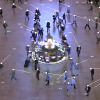An experimental evaluation of grouping definitions for moving entities
DOI:
https://doi.org/10.5311/JOSIS.2022.24.160Keywords:
trajectories, collective motion, groups, experimental comparisonAbstract
One important pattern analysis task for trajectory data is to find a group: a set of entities that travel together over a period of time. In this paper, we compare four definitions of groups by conducting extensive experiments using various data sets. The grouping definitions are different by one or more of three different characteristics: whether they use the measured sample points or continuous movement, how distance is used to decide if entities are in the same group, and whether the duration of the group is measured cumulatively or as one contiguous time interval. We are interested in the differences between the definitions and comparisons to human-annotated data, if available. We concentrate on pedestrian data and on different crowd densities. Furthermore, we analyze the robustness of the definitions with respect to their dependence on different sampling rates. We use two types of trajectory data sets: synthetic trajectories and real-life trajectories extracted from video surveillance. We present the results of the quantitative evaluations. For experiments with real-life trajectories, we augment them with a qualitative evaluation using videos that show groups in the trajectories with a color coding.

Downloads
Published
Issue
Section
License
Copyright (c) 2022 Lionov Wiratma, Marc van Kreveld, Maarten Löffler, Frank Staals

This work is licensed under a Creative Commons Attribution 3.0 Unported License.
Articles in JOSIS are licensed under a Creative Commons Attribution 3.0 License.
